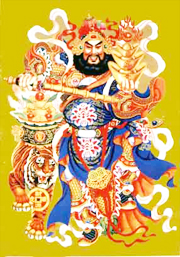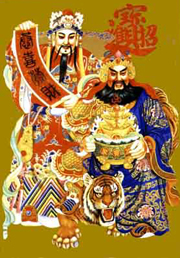Paper Joss
Origin and Development of Paper Joss
Feudal China was backward in many ways. Most laboring people toiled year after year without enough to eat and wear. The farmers longed for a bumper harvest, the handicraftsmen hoped to have a brisk market, the fishermen prayed for a large catch, the silkworm raisers wished for a cocoon boom.  Everyone wanted a healthy and prosperous family free from being bullied and oppressed by local corrupt officials. These hopes and desires were vividly expressed in a unique folk art form popularly known as zhi ma (paper joss, or paper horse, or paper-horse print) . Zhi ma was also called jia ma (first-rate horse). It was printed with the images of deities, gods and immortals created by the ancient people, which they worshiped and prayed to for blessings and happiness. paper joss was produced by carving the outline in relief of the god's image on a woodblock and then printing it in ink lines on colored paper . The prints were then burned as offerings and sacrifices. A historical study has shown that the paper horse or paper- horse print was originally printed with the additional image of a horse on which the god was said to ascend to heaven. thus, from the song Dynasty (960-1279 ) on, paper joss was known primarily as paper horse. The emergence of paper joss was closely connected with totems in ancient China.
Everyone wanted a healthy and prosperous family free from being bullied and oppressed by local corrupt officials. These hopes and desires were vividly expressed in a unique folk art form popularly known as zhi ma (paper joss, or paper horse, or paper-horse print) . Zhi ma was also called jia ma (first-rate horse). It was printed with the images of deities, gods and immortals created by the ancient people, which they worshiped and prayed to for blessings and happiness. paper joss was produced by carving the outline in relief of the god's image on a woodblock and then printing it in ink lines on colored paper . The prints were then burned as offerings and sacrifices. A historical study has shown that the paper horse or paper- horse print was originally printed with the additional image of a horse on which the god was said to ascend to heaven. thus, from the song Dynasty (960-1279 ) on, paper joss was known primarily as paper horse. The emergence of paper joss was closely connected with totems in ancient China.
According to historical records, most people in ancient China used to wear and hang up paper charms to celebrate festivals. For instance, on the first five days of lunar May, people put up the "Five- thunder Amulet" and wore small paper charms. On the fifteenth day of lunar August, they offered sacrifices to the moon. In the meantime, the print workshops put moonlight prints on the market for sale. They featured a full moon with a Buddha seated on a lotus base and, nearby, a little rabbit standing on its hind legs grinding medicinal herbs in a mortar. These prints ranged in size from a square cun (3. 3 cm) to a square zhang (3.3m)4. On the twenty-fourth day of lunar December, people used to feed fodder to the Kitchen God's horse, believing that the venerable god would ascend to heaven on it. And on the twenty- fifth, people burned joss-sticks to greet the jade Emperor, who would descend from heaven to inspect worldly affairs5. The prints "Kitchen God" and "Jade Emperor" are works from Beijing.
The Printing and Variety of Paper Joss
 Old printing wood blocks didn't wear well, blurring gradually due to frequent printing. The artisans had to frequently cut new ones after the original sketches. in cutting wood blocks, the image of the god was first traced in ink on a transparent paper which was then glued onto the woodblock. then the skilled craftsman cut the outlines of the image in relief along the traced lines. In printing, the woodblock was first evenly inked and then a sheet of fine paper was pressed on it. In order to print with high efficiency, craftsmen usually fixed fifty to one hundred sheets of paper in a position and turned and printed one after another. When colors such as red and green were required, the artisan applied them with a brush directly onto the print. Exquisite colored works from Wuxi, Suzhou, Tianjin and Yangliuqing were done either by pressing colored wood blocks on the print or by a folk artisan adding colors to the image's facial features with a brush.This process was popularly known as "opening the face." Among existing ancient examples, a few are excellent hand-painted works, most were printed with ink and woodblock and designed to be burned as offerings. Because the gods the people worshiped belonged to heaven and earth, they were not to be kept at home for a long time. However, the family gods, i.e. , the kitchen God and the Door God, were changed once a year or at longer intervals and so were printed exquisitely. Judging from the contents and subject matter of these prints, it seems reasonable to classify them into five groups:
Old printing wood blocks didn't wear well, blurring gradually due to frequent printing. The artisans had to frequently cut new ones after the original sketches. in cutting wood blocks, the image of the god was first traced in ink on a transparent paper which was then glued onto the woodblock. then the skilled craftsman cut the outlines of the image in relief along the traced lines. In printing, the woodblock was first evenly inked and then a sheet of fine paper was pressed on it. In order to print with high efficiency, craftsmen usually fixed fifty to one hundred sheets of paper in a position and turned and printed one after another. When colors such as red and green were required, the artisan applied them with a brush directly onto the print. Exquisite colored works from Wuxi, Suzhou, Tianjin and Yangliuqing were done either by pressing colored wood blocks on the print or by a folk artisan adding colors to the image's facial features with a brush.This process was popularly known as "opening the face." Among existing ancient examples, a few are excellent hand-painted works, most were printed with ink and woodblock and designed to be burned as offerings. Because the gods the people worshiped belonged to heaven and earth, they were not to be kept at home for a long time. However, the family gods, i.e. , the kitchen God and the Door God, were changed once a year or at longer intervals and so were printed exquisitely. Judging from the contents and subject matter of these prints, it seems reasonable to classify them into five groups:
Deities worshiped by farmers: Shennong (god of Farmland), Ox King, Horse King, god of Young Crops,Goddess of silkworms, King of Insects, God of Water, God of Hailstones, God of the Threshing Ground, Barn God, Pen god, Village God, God of Carts, God of Locusts, flower Goddess of Four Seasons, God of Livestock, God and Goddess of Wealth and General Liu Meng.
 Deified founders of trades and professions: The Emperor Huangdi (for tailors), the Fairy Feilu (for embroiderers), God Lu Ban( for carpenters and building workers), God Sun Bin (for shoemakers and clay sculptors), God Li Er (for smelters), God Du Kang (for wine- makers) , Confucius, or the Greatest Sage (for teachers), God Meng Tian ( for writing-brush workers), God Cai Lun (for paper-makers) , God Qingyuan Miaodao (for theatrical troupes), Goddess of Mercy in white ( for jade carvers), Immortal Lu Dongbin (for Chinese inkstick makers), God of Lu Yu (for tea shop workers), God Wu Daozi (for painters) , the Emperor Xuan of the Han dynasty (for large-pancake shop workers), Immortals Mei Fu and Ge Hong (for dyeing workers), God Da Mo (for pedicurists) , God of Medicine (for medical workers), God of Literature ( for printers) , Immortal Liu Hai (for needle-makers), the Buddha Ouqi( for silver-smiths), God in Charge of Life-span (for cooks), Gods of Three Justice (for butchers) and God of Wealth (for businessmen).
Deified founders of trades and professions: The Emperor Huangdi (for tailors), the Fairy Feilu (for embroiderers), God Lu Ban( for carpenters and building workers), God Sun Bin (for shoemakers and clay sculptors), God Li Er (for smelters), God Du Kang (for wine- makers) , Confucius, or the Greatest Sage (for teachers), God Meng Tian ( for writing-brush workers), God Cai Lun (for paper-makers) , God Qingyuan Miaodao (for theatrical troupes), Goddess of Mercy in white ( for jade carvers), Immortal Lu Dongbin (for Chinese inkstick makers), God of Lu Yu (for tea shop workers), God Wu Daozi (for painters) , the Emperor Xuan of the Han dynasty (for large-pancake shop workers), Immortals Mei Fu and Ge Hong (for dyeing workers), God Da Mo (for pedicurists) , God of Medicine (for medical workers), God of Literature ( for printers) , Immortal Liu Hai (for needle-makers), the Buddha Ouqi( for silver-smiths), God in Charge of Life-span (for cooks), Gods of Three Justice (for butchers) and God of Wealth (for businessmen).
Popular gods of Buddhist and Taoist inspiration: Sakyamuni, Jade Emperor, Three Great officials,God of Earth, God of Ziwei, God of Gouchen, God of the Town, Goddess of sight, God of War, Great Immortal Huang, God of Plague, God of the white Tiger, God Protecting and Blessing Local People and God Supervising Curses.
Social customs: Ruler of Heaven Granting Happiness, God of the South Pole, Queen Mother in Western Paradise, Heavenly Immortal Delivering sons, Immortal Xiao Shi, god Nong Yu, Dragon Vehicle of Heaven and Earth, God of the Star at the Tip of the Bowl, Immortal Zhang Xian Protecting Children, Immortal Tianshi, the Divine Taiji Chart (an auspicious symbol), God Zhao Gongming, God Bringing in Wealth and Treasures, the Three Stars(Happiness, Emolument and Longevity) , Black Dragon Presenting Happiness, God Jiang Taigong, god of Jupiter, Lord of Hell, Ten Heavenly Kings, Six Family Sages, Gods from Five Directions, Buddhist Sutra Dispelling Enmities and Buddhist Incantations.
Seasonal auspicious folk prints: Playing Cards Printed with Heroes from Outlaws of the Marsh, Promotion to a Higher Rank, Spring Ox, Table Showing Eighty-one Days That End Cold Weather, Zhong Kui( the demon killer), Tiger Suppressing Five Poisons,Horse of Emolument, Five Blessings, Family Blessed with Good Fortune, Ruler of Heaven Blessing Good Fortune, Riverside pavilion (for contracts), Door God, Kitchen God , God of Sun and Goddess of Moon.

